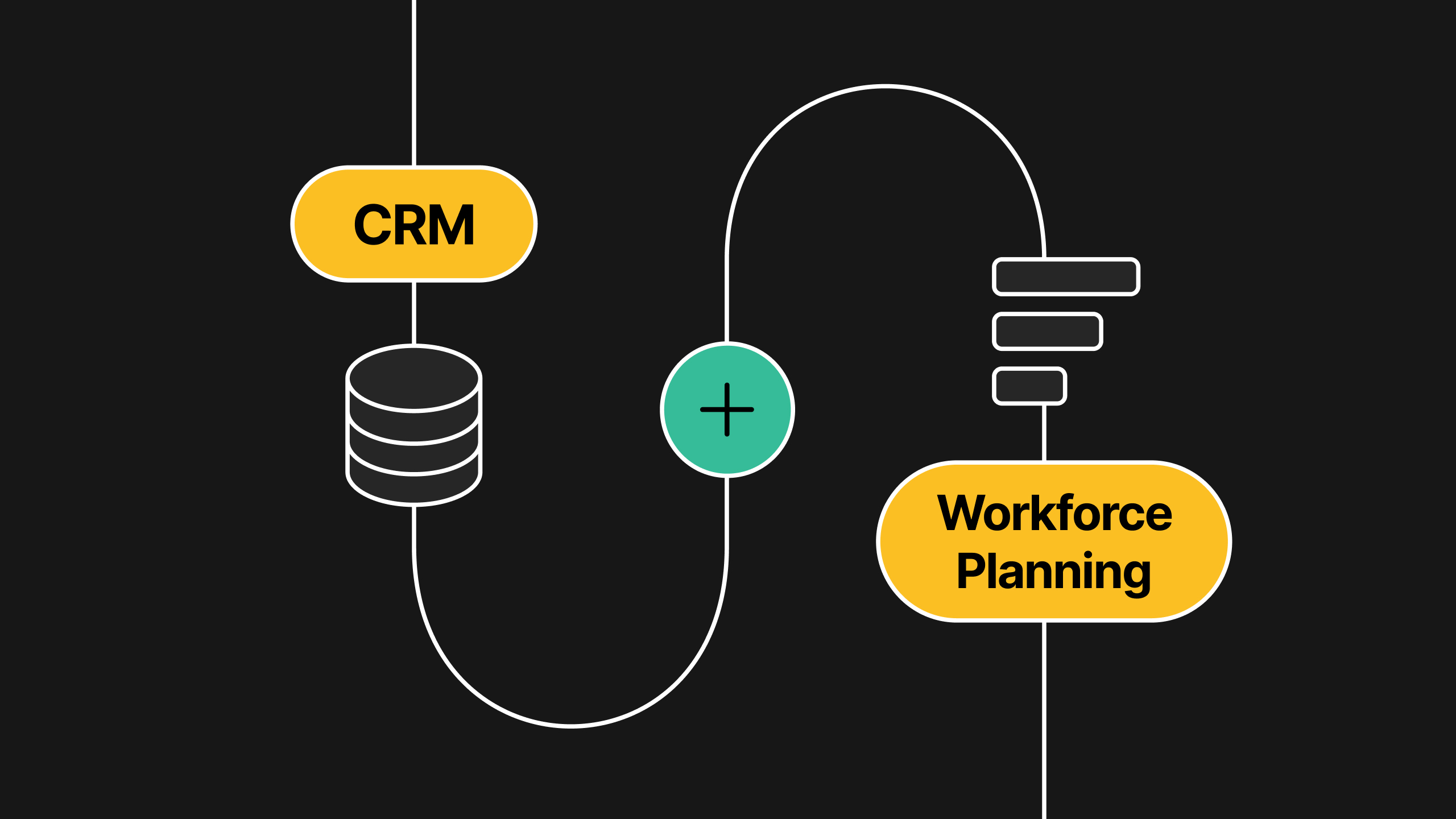
Combining CRM with Workforce Planning: Redefining Preconstruction Excellence
Refreshed mindsets and new tools point to a more united preconstruction.
October 17, 2023
12 min read
CRM

Caleb Taylor
Founder at Buildr

In the construction industry, there exists a longstanding divide: the Business Development and Operations departments have traditionally functioned in their own silos despite their collaboration being integral to a smooth and efficient preconstruction phase.
Construction is complicated; nothing new there. But the reasons for the departmental siloing aren't as complicated as you'd think.
Let's get into causes first, then the solutions.
The chasm between Business Development and Operations
Like many outdated processes in construction, the siloing between Business Development and Operations persists due to a tragically perfect storm of happenstance. The following feedback loop is too familiar a refrain for many general contractors today:
What's working now has been working just fine for the last x amount of years.
The time it would take to find, vet, and successfully implement a new piece of software that negates a process we already have in place would be too costly to our bottom line to even attempt such an endeavor.
There's no good software solution to bridge the divide between Business Development and Operations in the first place.
Business Development, with its keen eye on generating new opportunities and nurturing existing relationships for the benefit of repeat work, often exists in a bubble separate from the grit and grind of day-to-day Operations, where the chess-like tactics of staffing projects is at the forefront.
Surely, the two departments working closer in tandem could only be beneficial to the pursuit of the right jobs and the staffing of the best workforces on those jobs.
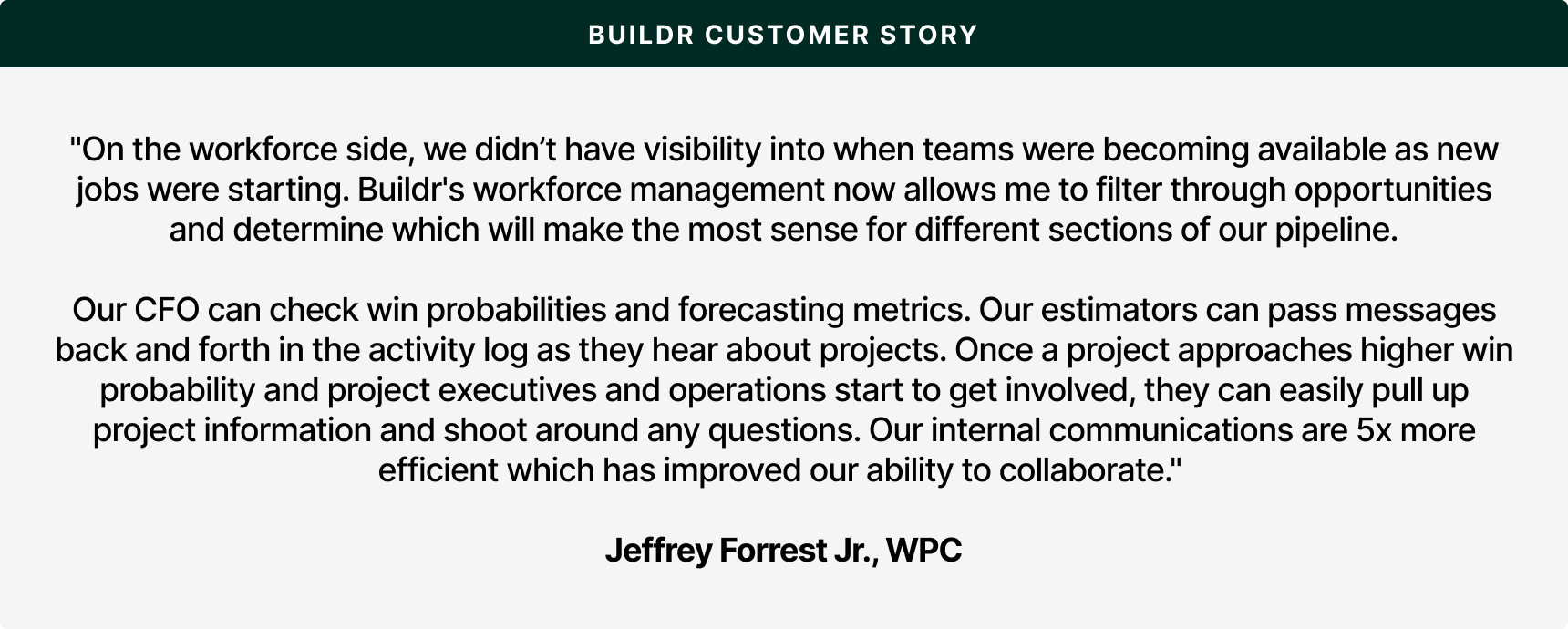
The pitfalls of inefficient Preconstruction
Inefficient preconstruction leads to plan and drawing inconsistencies, inefficient supply and material purchasing, poor trade coordination and often heavy cost and schedule overruns that only reinforce the animosity between isolated stakeholders. Too long, didn't read: Inefficient preconstruction = lower profits and a worse reputation.
We're more connected now than we've ever been. The real-time passage of information between GC and client makes it so that client expectations are crystal clear. GCs are being brought on earlier to nip supply chain snafus in the bud.
Heightened communication leads to shrinking timelines (a 33% shorter preconstruction phase estimates general contractor Mortenson, which puts pressure on designers, planning and material procurement). GCs are in a pinch due to the skilled labor shortage, meaning reliance on good collaborative preconstruction software that's easy to learn and use is a must. Software that specifically bridges the divide between workforce planning and opportunity pursuits/client relationship management? Sounds like a no-brainer.
Accelerated Preconstruction—the shift that's finally breaking down silos
The modern construction landscape is currently experiencing a paradigm shift.
The evolving demands of clients, the rapid pace of technological advancements, and the sheer complexity of projects are driving our industry to reevaluate this till-now compartmentalized approach that divides the different preconstruction departments.
Recently, we've seen integrations between formerly disparate workflows in preconstruction that are needed faster than they're being built. This is why an open API is so important; a topic for another blog on another day.
An accelerated preconstruction process is one of the permanent results of the pandemic. Clients expect expedited communication and movement. Every second counts.
Construction Dive recently published a series on preconstruction that dives into the why (and why now) preconstruction is the favorite child phase of construction when it comes to optimization. The 3-part series is a fascinating investigative deep-dive that picks the brains of forward-thinking general contractors like McCarthy, Mortenson, Messer, and PCL that have fully embraced improving preconstruction to ensure longterm business success in a post-pandemic world.
Some high-level notes of the series:
When COVID-19 forced everything to stop, it gave a breath for self-reflection on how janky (our words not theirs) and disconnected the preconstruction process really was.
Regardless of delivery model, GCs say precon project collaboration is happening much earlier than ever with greater transparency and communication.
Preconstruction is happening earlier but it's also speeding up. Owners are "looking at preconstruction as the Rosetta stone for speedier market delivery."
“Technology will change how we do things, and I’ve seen it change things ever since I’ve started in the industry,” said Eric Orquiola, Director of Preconstruction, PCL Construction. “Whether efficiency is found in technology or lean delivery or whatever else is out there, we need to change processes to meet client needs, because we can’t hire as fast as the projects are coming in.”
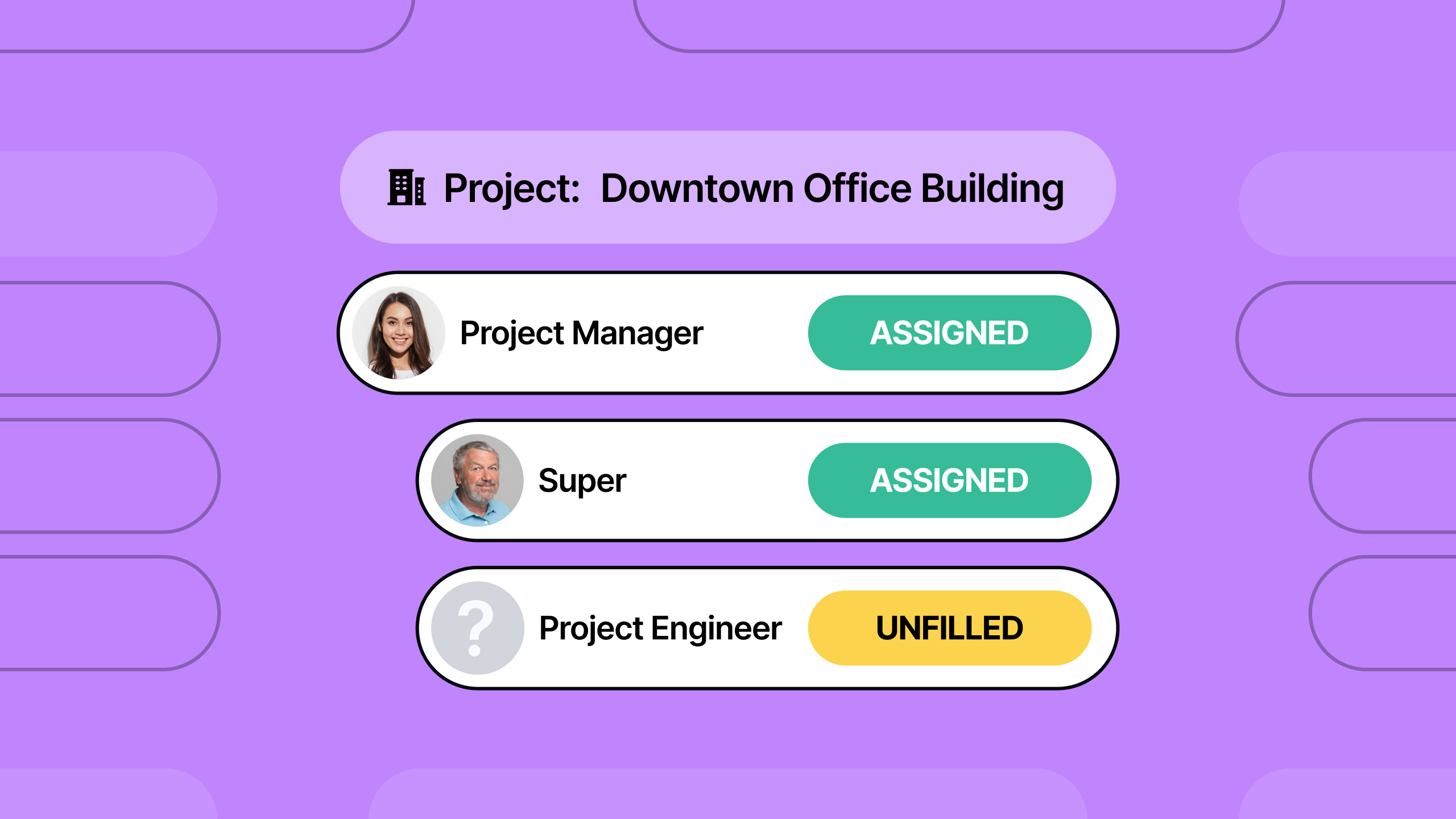
Why the bridging of Business Development and Operations makes so much sense
Business Development and Operations can no longer afford to work in isolation. The obvious answer is integration, a seamless blending of strategies and tasks to optimize outcomes, reduce redundancies, and ensure every project is not just completed, but completed to a degree that is excellent.
This new era of ours beckons a more interconnected, collaborative methodology—and integrating your CRM with workforce planning lies at its heart.
Let's get into the benefits of a CRM-Workforce meld:
1. Real-time data synchronization
We're beating a dead horse here—the drawbacks of manual/spreadsheet-based data management are many. Most tech companies in our industry get a foothold by bashing spreadsheets, pointing out their horrible inefficiency, lack of collaboration, and perhaps worst of all, their ineffectiveness in keeping data that lives in different places fully synced up.
Having a workforce management system within your CRM—or, at least a working integration between the two—ensures your data remains flush across the board. This way, someone out in the field can update an opportunity on their CRM's mobile app while someone in Operations back in the office 15 miles away can instantly see the update and start cranking away on a few sample workforce assignments to see if there's a good lineup at that time of the year.
This is preconstruction on steroids, and it's going to be the norm very soon.
With synchronized preconstruction data, there's a significantly reduced risk of human error and the elimination of tedious cross-referencing tasks. No more trying to locate the folder with that one spreadsheet whose most up-to-date version was actually updated 18 minutes ago and you have no idea.

2. Workforce planning foresight and flexibility
At Buildr, we firmly believe that workforce forecasting will soon be an integral part of the Go/No-go process for most general contractors.
There are endless benefits of setting up views within your construction CRM that can filter for potential jobs. Pre-planning and tinkering with workforce setups before a job's even been won can give you a massive competitive advantage that helps you zero in on the right jobs.
How adequately you can staff a job and execute on it to a degree that will knock your client's socks off will determine if you work for that client again. We hit the "repeat work is the life-blood for GC's" gong every chance we get in this blog, and repeat work has never been less assured with so much competition and so many variables in the marketplace today.
The versatility offered in timing new assignments without being restricted by syncing to project start dates is important when vetting a workforce-CRM integrated process. For example, assigning multiple superintendents and other roles with staggered start dates as per project requires.
This level of flexibility is why whiteboards are so common in the industry. Now imagine the flexibility of a whiteboard that includes every conceivable edit synced across every department of your preconstruction—with no risk of the nighttime cleaning crew erasing everything. That's what Buildr, and similar construction-specific CRMs, aim to provide.
Tired of disconnected spreadsheets hurting your bottom line?
3. Better utilization, higher profitability
Workforce utilization is also a necessary facet of Operations (and Business Development, symbiotically). Would taking on a certain job over-utilize your best workers and burn them and your company out in the long-run?
When we're thinking about profit margins, you want to take into account utilization as a whole at your company. Builders should aspire to be as close to 100% utilization as possible to ensure they're as profitable as they can be. With a labor shortage and increased cost of inputs, leaving any money on the table because you're letting some employees sit on the bench would be, to put it lightly, administratively inept.
The best Workforce-CRMs let you adjust utilization on the fly not just in the present, but in the future, so that your current profitability isn't short-lived.

4. More efficient data filtering and better views
Construction CRM with custom field filters can help derive insights that are specific to your workforce planning. Compared to the more manual methods of workforce planning—like the kind traditionally done on spreadsheets—a more integrated process can unveil a new level of user-friendliness and efficiency.
Have you ever been in a team meeting where a question arises that can't be immediately answered without some quick juggling of data between multiple Excel sheets?
When Business Development and Operations are siloed, answering questions—that either department might only have a piece of that answer to—slows preconstruction to a crawl and invites miscommunication. Miscommunication invites tension and the possibility for incorrect assumptions to be made. It makes sense; assuming is quicker and easier than asking.
Board view and Map view
Board view, sometimes referred to as Kanban view, is a visually satisfying way to interpret and manipulate data when endless rows of spreadsheet cells aren't cutting it. This view exists in Buildr and most construction-specific CRMs worth their weight.
Dragging jobs from one stage to another (ie., a project that moves from Prospecting to Estimating) simplifies the workflow. This visual representation can be beneficial for those who find spreadsheet views overwhelming or unclear.
Think of Board view as digital sticky notes, except you know, infinitely less precarious because none of the stickies can lose their hold and fall to the floor.
Likewise, Map view allows a bird's eye view of your potential and won jobs as well as your staff relative to them. This makes staffing jobs so much easier, especially when gas money and the logistics of employee commute come into play.
5. Seamless dashboard transitioning
The interconnectedness of CRM and workforce planning software provides a seamless way to hop between dashboards to see the full picture of your overall book of business.
We've already highlighted the advantages of simultaneous updates across a cloud platform, ensuring consistent and accurate data across the board. But to actually see that real-time data visualized and contextualized into dashboards that update in real-time is compelling.
A unified bird's eye view aids in better decision-making, efficient resource allocation, and improved project forecasting.
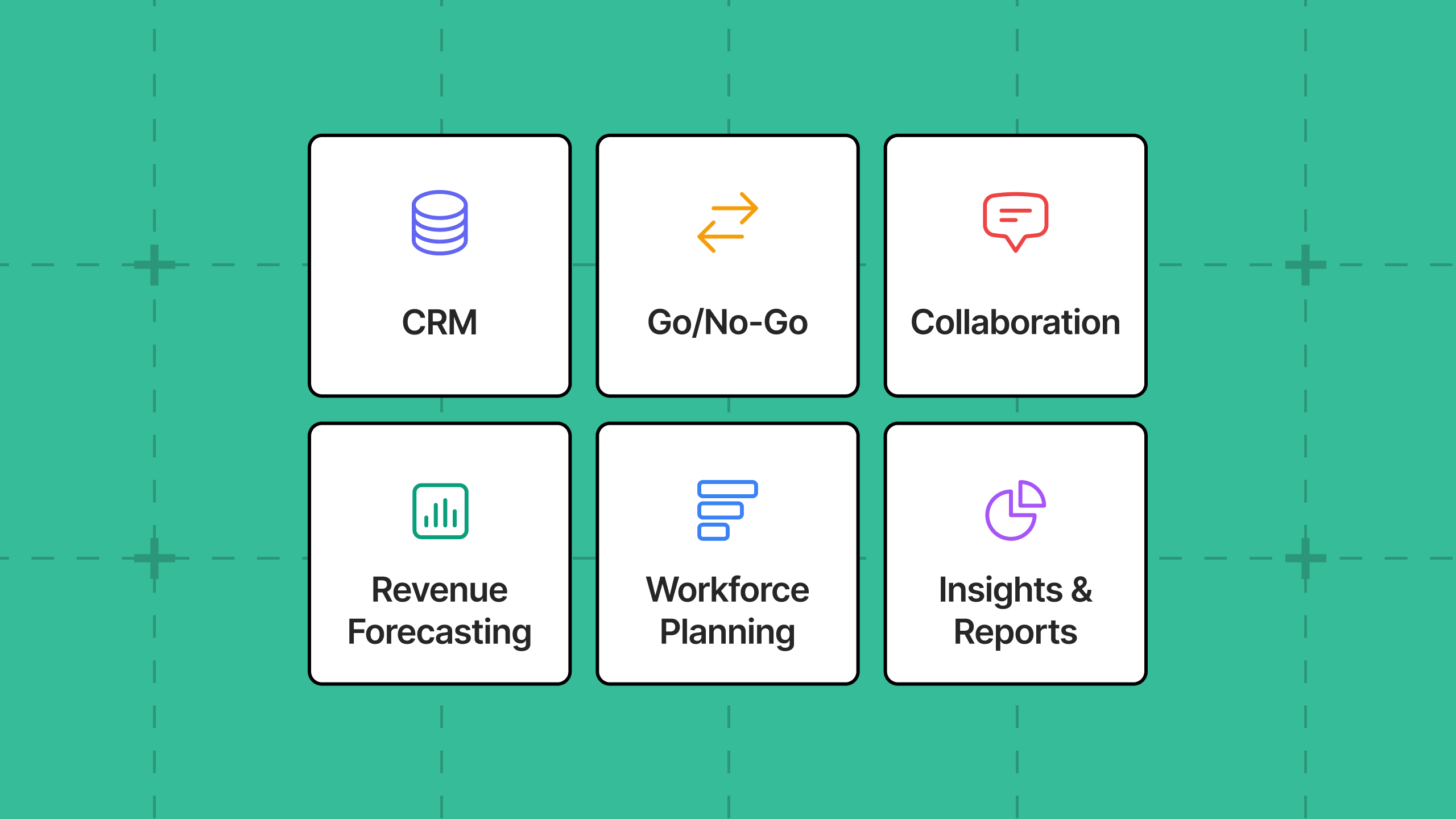
It's broke, so let's fix it
"That's the way we've always done it," for better or worse, is an old adage that everyone says at some time or another. The "if it ain't broke" assumption has led to the creation of rigid silos that stand between Business Development and Operations, often stunting the growth and innovation of preconstruction at large.
Just because a process is by all accounts "working," doesn't mean it's not "broke." It's about adapting to the future and ensuring that our industry doesn't just survive, but thrives.
Breaking down the barriers between Business Development and Operations isn't just a passing trend—it's an imperative that will soon be the norm. Much like course-of-construction software being ubiquitous in our industry, we'll one day wonder "how did we ever survive before that?" in regards to united preconstruction teams.
Integrating your CRM together with your workforce planning isn't just a merger of tools for the sake of consolidation; it's a harmonization of processes that deserve to be a single process.
With this integration, construction firms can enjoy real-time data synchronization, negating the hassle of manual updates. It provides the flexibility to plan and adjust workforces even before a project begins, giving companies a competitive edge. More so, the seamless dashboard transition between CRM and workforce planning offers a consistent and unified view that aids in precise decision-making, ensuring that resources are utilized optimally.
It's time to pave the way for a brighter construction future—don't let old habits hold you back. Embrace the integration of CRM and workforce planning, and watch how your preconstruction processes become more streamlined and efficient. By tracking potential jobs alongside scheduling workforces for them, you'll achieve greater profitability.
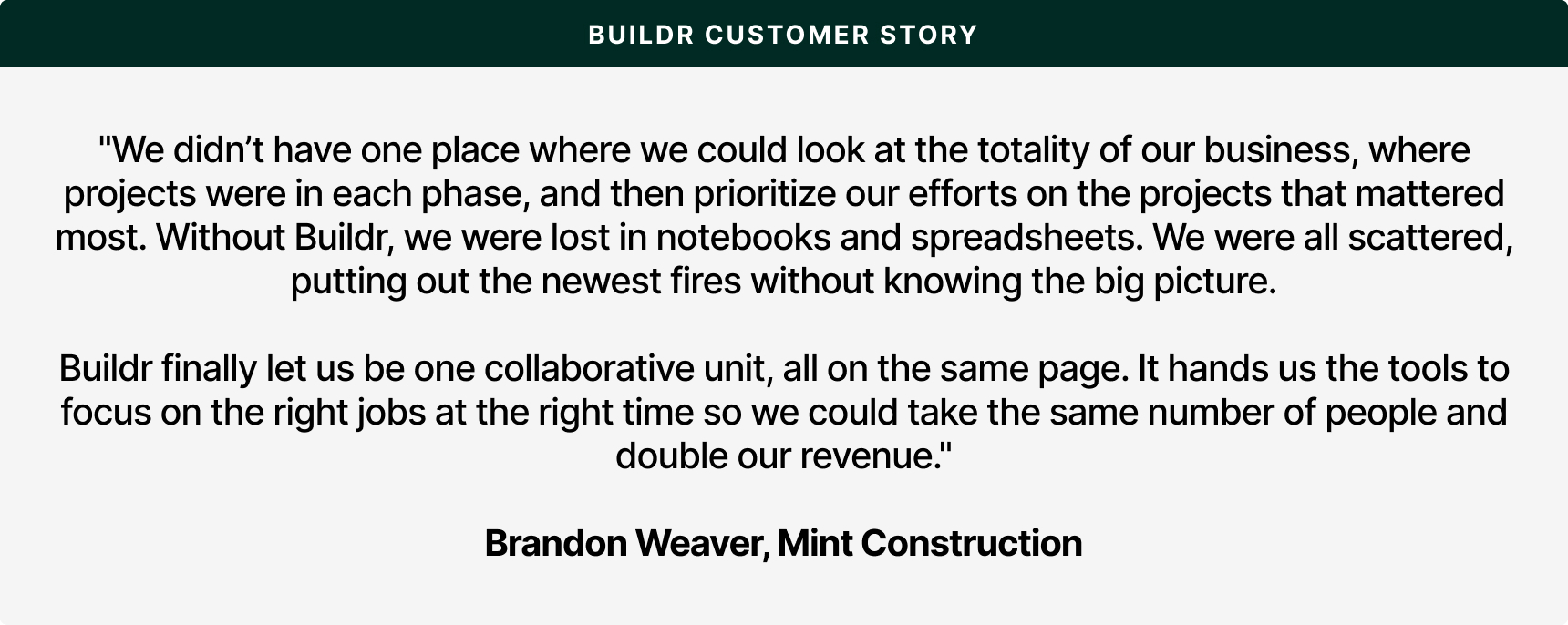
To read more success stories about how general contractors are finding success in an integrated workforce and CRM process, be sure to check out our customer story page.
Stay in the loop
Seriously, you should sign up to be a construction insider. Everyone will be so jealous of you.